In the world of dating apps, 2025 is shaping up to be the year of video.
As more people crave interactive and immersive experiences, the demand to create a video dating app is skyrocketing.
If you're a tech entrepreneur or investor looking for the next big thing, video dating app development is the way to go.
It’s fun, exciting, and caters perfectly to today’s digital-first generation. Let’s dive in and see how the journey of video dating app development unfolds.
Without any further ado, let’s get started:
Overview of Video Dating Apps
A video dating app is a modern evolution of traditional dating platforms, offering real-time interaction that helps users build trust and chemistry right from the start.
No more guessing behind a profile picture– users can see, hear, and interact with each other in a more authentic and meaningful way.
From an investment standpoint, this represents a huge shift in how people approach online connections. Video dating apps are not just about improving user experience-they’re creating a real, personal, and immersive connection that digital platforms have struggled to offer.
As an investor, the opportunity here is clear. Video dating apps are the next frontier in the dating industry, offering potential for high user engagement, better retention, and an innovative way to capture a growing market that craves genuine, face-to-face connections.
For those looking to create a dating app that truly stands out and taps into this future-forward trend, investing in a video dating app is a smart move. The market is ready, and the digital dating world is ready for a revolution.
Video Dating App Market Insights
The video dating app market is growing rapidly, and the dating app statistics back this up.
Here’s why you should consider stepping into it.
-
- Global Market Value: The online dating market is expected to generate $3.17 billion in revenue by 2025. With a projected compound annual growth rate (CAGR) of 2.14% from 2025 to 2029, the market is anticipated to reach a total value of $3.45 billion by 2029.
- Shift Toward Video Dating: About one in five singles tried virtual dating during the height of the pandemic.
- User Engagement: Video profiles and calls lead to 33% higher engagement rates compared to text-based profiles, making them a powerful tool for building stronger connections.
- User Base Growth: Apps that integrate video features saw a 20% increase in user sign-ups and activity during the pandemic, emphasizing the increasing value of video in online dating.
These stats reflect a growing trend towards more immersive, authentic experiences in dating apps, which is why creating a video-based dating app development project can be a smart business move.
How to Develop a Video Dating App: Step-by-Step Guide
Video dating apps have gained massive popularity, and for good reason.
They offer users the opportunity to connect face-to-face in a digital space, making online dating feel more authentic and personal.
If you’re looking to create your own video dating app, you're entering a competitive yet exciting market.
But don't worry-this guide will take you through everything you need to know, from defining your app’s concept to choosing the right technology stack and ensuring a seamless user experience.
Let’s break down the essential steps involved in developing a video dating app that stands out and meets the needs of your target audience.
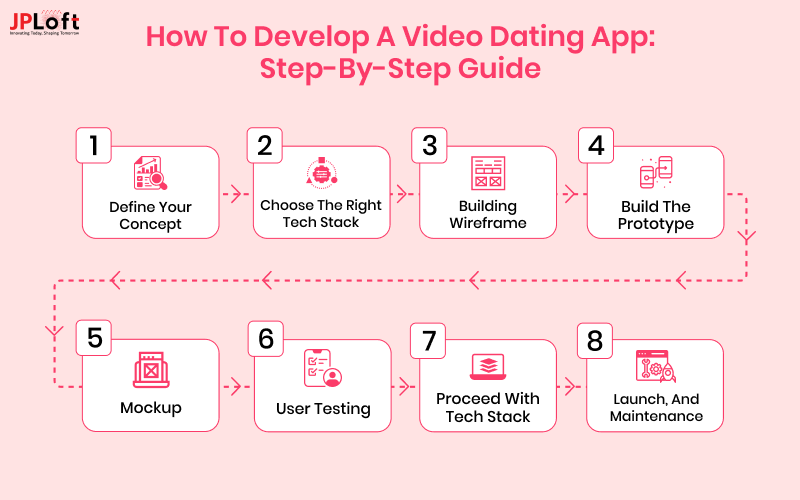
Step 1: Define Your Concept and Niche
Before you dive into the development process, you need to have a clear concept. This is the first step in how to create a video dating app that captures attention.
Figure out what sets your video dating app apart from the millions of others out there? Do you have a specific audience in mind, or are you targeting a broad user base?
Key Questions to Ask:
-
- Target Audience: Will your app serve general users or cater to a specific niche? Think about pet lovers, fitness enthusiasts, gamers, or even specific age groups.
- Unique Features: What unique value will your app offer? Features like AI-driven matchmaking, interactive filters, or virtual date events could set your app apart from competitors.
- Monetization Strategy: How will you make money from your app? Will it be a subscription-based model, in-app purchases, or ad-based revenue?
Having a solid concept will serve as the foundation of your app’s development and guide your choices along the way.
Step 2: Choose the Right Technology Stack
The dating app tech stack you choose while video dating app development will determine how scalable, reliable, and efficient your video dating app is.
Since the core functionality revolves around video calls and real-time interaction, you need to choose technologies that can handle video streaming with minimal latency and high-quality performance.
-
- WebRTC (Web Real-Time Communication): WebRTC is the backbone of any real-time communication app, enabling peer-to-peer video, audio, and data sharing. It’s open-source, highly scalable, and allows you to implement low-latency video calls directly in your browser.
- Video Streaming Services: If you want to offload some of the heavy lifting, using a third-party service like Agora, Daily.co, or Twilio can simplify video call integration. These platforms provide robust, low-latency video streams and APIs to streamline development.
- Backend Development: Choose a backend framework that can handle high traffic and data, such as Node.js, Django, or Ruby on Rails. A scalable backend is crucial for handling large volumes of users, profiles, and video data.
- Database Solutions: Use databases like MySQL, PostgreSQL, or MongoDB to store user data, profiles, matches, and chat logs. You should also look into cloud-based storage services (Amazon S3, Google Cloud) to store video and media files securely.
- Cloud Infrastructure: Choose a cloud provider like AWS, Google Cloud, or Azure to host your app. Cloud services provide scalability and security, especially when dealing with video streaming, which can consume a lot of bandwidth.
- Front-End Development: Focus on creating an intuitive, engaging user interface using frameworks like React or Vue.js for a responsive experience. Ensure that your app is mobile-first, as most dating apps are accessed on smartphones.
The tech stack plays a pivotal role in how to build a video dating app that delivers exceptional real-time performance.
Step 3: Prioritize Safety and Privacy Features
When you develop a video dating app, user safety is a significant concern. You must ensure that your video dating app has robust privacy and security features.
By focusing on privacy, you show your users that their safety is a priority when learning how to create a video dating app.
Not only do these features protect your users, but they also help build trust, which is essential in the online dating space.
-
- User Verification: Implement multiple layers of verification to ensure that users are who they claim to be. This could include phone number verification, email verification, or even facial recognition.
- AI-Driven Moderation: AI-powered tools can help detect inappropriate behaviour, such as offensive language or inappropriate content, during video chats or profile creation.
- Video Encryption: To protect sensitive video data, use end-to-end encryption during video calls. This ensures that conversations are private and not accessible to third parties.
Step 4: Design for a Seamless User Experience
The UX design is a key element when figuring out how to develop a video dating app that engages users and keeps them coming back.
Since your app revolves around video communication, it’s essential that users can quickly and easily initiate video calls, connect with matches, and navigate through the app smoothly.
Creating an app wireframe and app prototype helps ensure a smooth flow and intuitive interface, providing a solid foundation for development and testing.
-
- Intuitive Interface: Keep the app simple and intuitive. Allow users to easily set up profiles, browse matches, and initiate video calls without any complexity.
- Personalized Matchmaking: Use algorithms that suggest potential matches based on interests, location, and preferences. This makes the experience more meaningful and increases user engagement.
- Interactive Video Features: Add fun elements like filters, virtual backgrounds, or in-app games to make video calls more engaging. The more interactive and personalized the experience, the more likely users are to stay.
- Minimal Load Time: Speed is critical for user retention. Ensure that your app loads quickly and that video calls connect instantly, as delays can lead to frustration.
- Mobile-First Design: The majority of your users will access your app via their smartphones, so it’s crucial to ensure your app is mobile-optimized. Consider using a mobile-first design approach to deliver the best experience across all devices.
Step 5: Develop and Test Your App
Once you’ve nailed down your concept, technology stack, and UX, it’s time to start building your video dating app.
-
- MVP (Minimum Viable Product): Start by creating an MVP that includes only the essential features, like profile creation, video calls, and matchmaking. This allows you to gather feedback and make improvements before going all in.
- Iterative Development: Once the MVP is live, continuously test and refine your app based on user feedback. This iterative process will help you enhance the app’s features and functionality.
- Beta Testing: Before launching to the general public, conduct extensive app testing with a small group of users. This will help you identify bugs and fix any issues with video calls, profile creation, or other app features.
Learning how to build a video dating app is an iterative process, where feedback is essential to improve the product.
Step 6: Launch and Marketing
After testing and finalizing your app, it’s time to launch. But creating an app is just half the battle – now you need to attract users.
Once your app is ready to launch, the next step is to figure out how to create a video dating app brand that attracts and retains users.
-
- Targeted Ads: Use social media platforms like Instagram, Facebook, and TikTok to run targeted ads aimed at your ideal audience. Video-based marketing can work particularly well here since it showcases your app’s core functionality.
- Influencer Partnerships: Collaborate with dating influencers or bloggers to promote your app. They can offer valuable exposure to your target market.
- Content Marketing: Publish blog posts, tutorials, and videos to showcase the benefits of your app. Make sure to address common questions or concerns users may have.
- Referral Programs: Consider adding a referral program to encourage users to invite their friends to join. Offering rewards like free premium memberships can incentivize sign-ups.
Step 7: Maintenance Strategies
Once your video dating app is live and users are engaging with it, your work is far from over. App maintenance services are just as crucial as the initial development phase.
Monetizing your app is an important part of how to develop a video dating app that is financially sustainable. It ensures that the app stays up-to-date, secure, and fully functional, offering users the best experience possible.
Here’s how you can approach maintaining your app:
-
- Bug Fixes & Updates: Continuously monitor the app for bugs or issues reported by users.
- Security Patches: Security threats evolve rapidly, so it’s essential to implement regular security patches to protect user data.
- Feature Enhancements: Based on user feedback and trends in the industry, periodically introduce new features or improve existing ones.
- Scalability: As your app’s user base grows, you’ll need to ensure that your infrastructure can handle the increased load.
- User Support: Keep your support system efficient by regularly updating FAQs, creating tutorials, and offering timely responses to user complaints or concerns.
- App Optimization: Over time, apps can become sluggish or consume too much battery. Regular optimization ensures that your app remains fast, responsive, and user-friendly.
Overall, to build a successful video dating app, it's crucial to follow a well-structured development process and implement a solid strategy.
Moving further with this guide to video dating app development, we’ll dive into the key features that will take your video dating app to the next level.
Essential Features for a Video Dating App
When you set out to create a video dating app, one of the most important aspects to consider is the features you'll offer.
A dating app feature list can significantly impact the user experience and ultimately determine your app’s success.
To ensure your app is both functional and engaging, it's essential to integrate features that cater to user preferences and enhance interaction.
The features of a video dating app go beyond simple chat functions, video calls, profile customization, and matchmaking algorithms are key to keeping users connected and engaged.
Let's take a look at the core features that every successful video dating app should include.
|
Feature |
Description |
|
Video Call Integration |
Real-time video calling functionality for users to connect face-to-face. |
|
User Profile Creation |
Customizable profiles where users can add photos, bios, and interests. |
|
Matchmaking Algorithm |
The intelligent algorithm that suggests compatible matches based on interests, location, and preferences. |
|
In-App Chat |
Text messaging system for users to communicate before and after video calls. |
|
User Verification |
Multi-layered verification to ensure authenticity and enhance user trust. |
|
Safety & Reporting Features |
Options to block or report inappropriate users, ensuring a safe environment. |
|
Filters & Virtual Backgrounds |
Fun and interactive filters, as well as virtual backgrounds, to make video chats more engaging. |
|
Push Notifications |
Real-time notifications to alert users about messages, matches, or new features. |
|
Privacy Settings |
Control over who can see the user’s profile and initiate contact. |
|
Subscription & Premium Features |
Monetization options like premium subscriptions for unlimited video calls, boosting profiles, or advanced features. |
Next up is cost, as it is on every investor's mind.
How Much Does It Cost to Develop a Video Dating App?
So, you're ready to bring your video dating app idea to life – but what's the price? Well, the dating app development cost can vary based on several factors, such as the features you choose, the complexity of your app, and the development team's location.
On average, developing a video dating app can cost anywhere between $50,000 to $150,000, depending on the scope of your project.
Here’s a breakdown of what goes into the cost to build a video dating app:
|
Development Stage |
Estimated Cost |
|
Planning & Design |
$5,000 - $15,000 |
|
App Development |
$25,000 - $80,000 |
|
UI/UX Design |
$5,000 - $20,000 |
|
Testing & QA |
$5,000 - $15,000 |
|
Launch & Marketing |
$10,000 - $30,000 |
|
Maintenance (Annual) |
$10,000 - $30,000 |
Remember, while building a video dating app requires an upfront investment, it has the potential for big returns if you deliver a product users love.
So, whether you're focusing on a niche audience or adding innovative features, the key is to plan wisely and build an app that’s both engaging and profitable!
Challenges in Developing a Video Dating App
When you build a video dating app, you're not just creating a product – you're shaping a unique experience.
But with that comes several challenges in dating app development, from user experience to user safety concerns. Here are some key obstacles to consider:
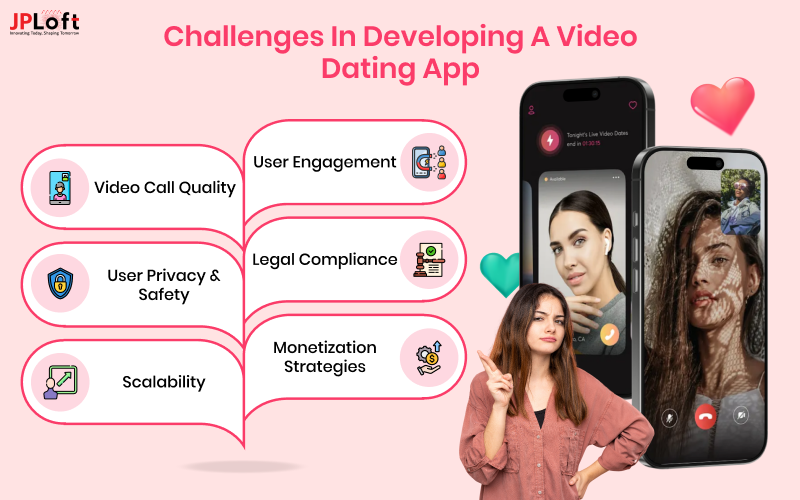
1. Video Call Quality
Ensuring seamless video calls with minimal latency is a challenge. As you develop a mobile video dating app, reliable infrastructure is necessary to maintain high-quality video, even under varying network conditions.
2. User Privacy & Safety
Privacy is paramount. You'll need to implement robust security measures like encryption and AI-driven moderation to protect users and maintain trust while creating a safe video dating environment.
3. Scalability
When your app gains traction, scaling it to handle thousands of simultaneous users without lag can be difficult. Make sure your platform can easily grow as your user base expands.
4. User Engagement
Keeping users hooked can be tough. When you create a video dating app, think about adding interactive features, like video filters or virtual events, to keep the experience fresh and exciting for your audience.
5. Legal Compliance
Different regions have varying laws around online dating. You must ensure that your app complies with data protection regulations, age verification, and other legal aspects to avoid issues down the road.
6. Monetization Strategies
Monetizing without disrupting the user experience is tricky. Balancing ads, subscriptions, and in-app purchases while keeping the app enjoyable is key to generating revenue.
Future Trends in Video Dating Apps
The video dating space is rapidly evolving, and staying ahead of the curve is crucial if you want to develop a video dating app that resonates with users.
As technology continues to improve and user expectations change, there are several dating app trends you should keep an eye on to stay competitive:
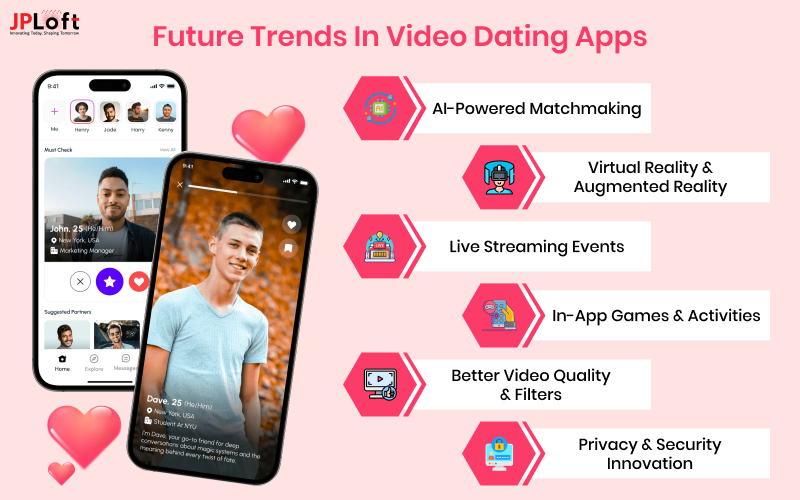
1] AI-Powered Matchmaking
Artificial intelligence is changing the way users are matched. By incorporating AI, you can create a video dating app that offers personalized match suggestions based on user behaviour, interests, and preferences.
2] Virtual Reality (VR) and Augmented Reality (AR)
In the future, VR and AR will play a bigger role in dating apps. Imagine virtual dates where users can interact in immersive environments could take video dating to a whole new level.
3] Live Streaming Events
Live streaming could become a central feature in video dating. Hosting virtual speed-dating events, group chats, or live interactions could make the app more engaging and offer a unique dating experience.
4] In-App Games and Activities
As the focus shifts to creating more engaging experiences, develop a video dating app with in-app games or fun activities to help users break the ice. These features will encourage longer interactions and more fun.
5] Better Video Quality and Filters
With the improvement of 5G technology, video calls will be smoother and more reliable. Expect enhanced video quality and fun interactive filters that could add a creative element to virtual dates.
6] Privacy and Security Innovation
As the app space gets more crowded, trust becomes critical. Privacy-focused features, such as encrypted video calls and advanced user verification, will become standard as users demand more control over their personal data.
How Do Video Dating Apps Make Money?
When it comes to video dating app development, one of the most exciting aspects for founders and investors is the dating app monetization potential.
These apps don’t just connect people- they’re built to generate consistent revenue through multiple income streams. Here’s how they turn virtual chemistry into real-world profits:
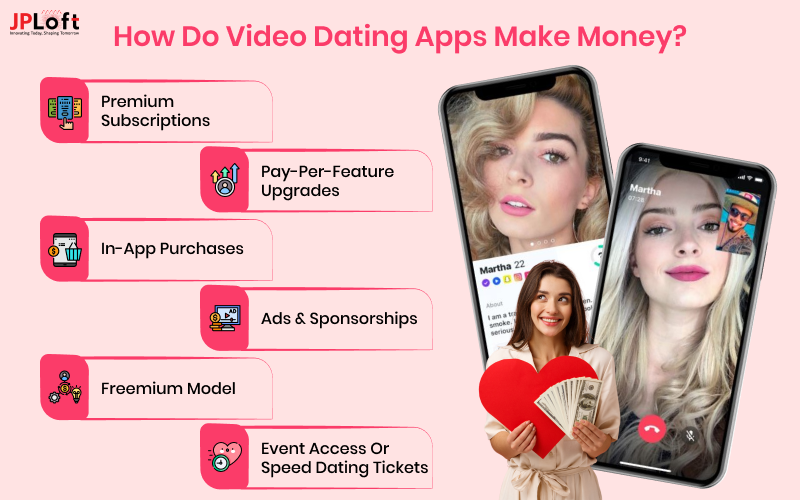
-
- Premium Subscriptions: Offer users access to VIP features like unlimited video calls, exclusive matches, rewind options, and profile boosts through monthly or annual plans.
- Pay-Per-Feature Upgrades: Let users pay one-time fees for extras like video filters, profile highlights, or seeing who liked them—instant perks, instant cash.
- In-App Purchases: Sell virtual gifts (like hearts, roses, or drinks) during live video chats to increase user engagement and revenue.
- Ads & Sponsorships: Integrate non-intrusive ads or collaborate with lifestyle brands for sponsored content that fits seamlessly into the app’s dating vibe.
- Freemium Model: Attract a large user base with free access and then upsell premium tools for better visibility or connection success.
- Event Access or Speed Dating Tickets: Host virtual speed dating nights or exclusive matchmaking events that users can pay to join - fun for them, profit for you!
With the right video dating app development strategy, these monetization models can be tailored to your user base and scaled effortlessly.
Develop a Video Dating App with JPLoft
Ready to take your idea and develop a video dating app that stands out from the competition?
JPLoft is a vetted dating app development company specializing in transforming innovative ideas into successful digital products.
With a team of experienced developers, we can guide you through every stage of the app development process – from concept to launch.
Whether you're looking to build a video dating app with unique features or want to incorporate cutting-edge technologies like AI or VR, JPLoft has the expertise to bring your vision to life.
We're here to ensure that your dating app not only attracts users but also keeps them engaged with seamless video experiences and intuitive design.
Conclusion
Creating a video dating app offers a unique opportunity to tap into the growing market of online relationships.
By focusing on user experience, security, and innovative features, you can build an app that stands out in a competitive space.
The future of video dating is bright, with trends like AI matchmaking, AR/VR integration, and live-streamed events reshaping the way people connect.
With the right approach and a trusted development partner like JPLoft, your video dating app can be the next big thing in the dating world.
FAQs
The development time depends on your app's complexity and the features you want to include. A basic app may take 4-6 months, while a more complex app could take 9-12 months.
The cost of building a video dating app depends on several factors, including features, design, and technology stack. Typically, it can range from $30,000 to $150,000 or more.
Essential features include profile creation, video calls, AI-powered matchmaking, in-app messaging, privacy settings, and user verification. Adding fun elements like filters or games will enhance user engagement.
Absolutely! Whether you want to cater to pet lovers, fitness enthusiasts, or professionals, a niche-focused video dating app can attract a loyal user base by offering tailored experiences.
At JPLoft, we have extensive experience in creating custom dating apps with seamless video features. Our team ensures your app is built with the latest technologies and meets your business objectives.






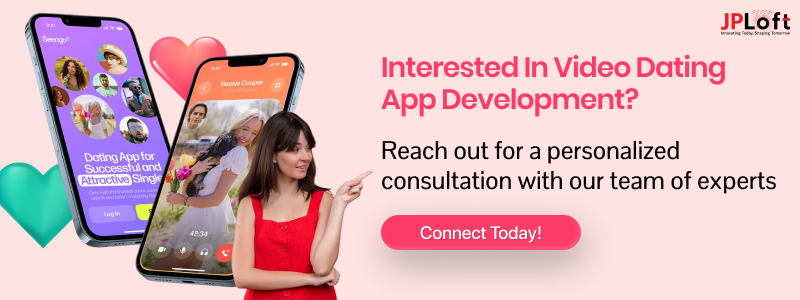


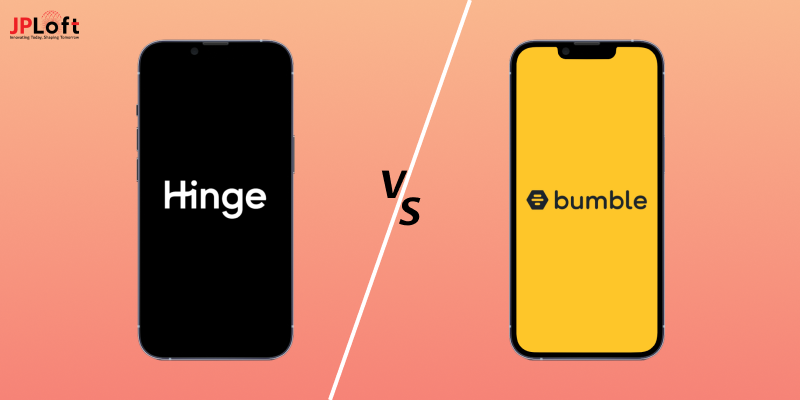
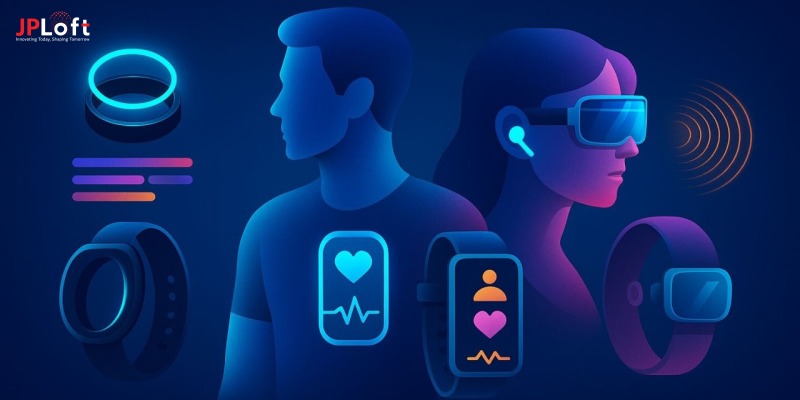


Share this blog